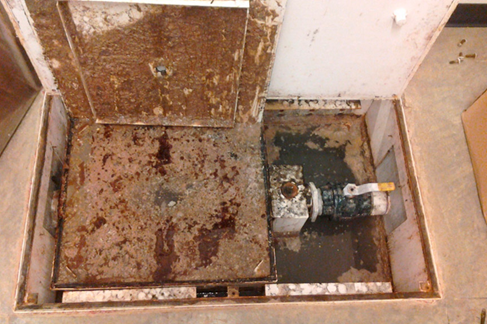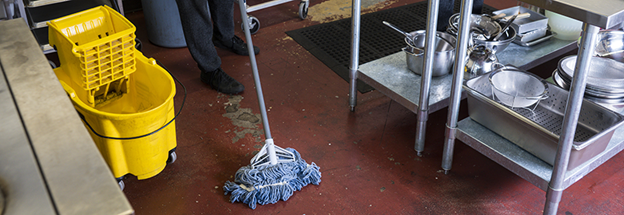What Can & Can’t I Put in My Grease Trap?
What Can & Can’t I Put in My Grease Trap?
When it comes to managing your facility, you’ve probably encountered questions about your grease trap before. Because really, you don’t want to have to deal with the fallout if something goes wrong. This begs the question: what can and can’t you put in your grease trap to keep it at prime functioning ability?
At State Chemical, we manufacture and distribute chemical solutions for various problems, including grease trap maintenance. It can be hard to know what taking care of your grease trap should look like, and you don’t want to deal with the mess and the bills if something goes wrong.
To help you keep your grease trap as well-maintained as possible, we will explain what you can put in your grease trap, what you shouldn’t put in your grease trap, how to avoid accidental drainage, and what grease trap maintenance should look like. After reading, you’ll know how to take the best care of your grease trap and avoid incurring additional expenses.
What is Safe for My Grease Trap?
So, what substances are okay to put in a grease trap?
A grease trap is designed to do what its name suggests: trap fats, oils, and greases (FOGs). This being said, the main substances that won’t cause problems for a grease trap are FOGs, including cooking oil, greasy residue, salad dressings, peanut butter, and other oily or fatty substances.
Now, you shouldn’t purposely put FOGs down the drain, as that can cause your grease trap to fill more quickly and need more frequent maintenance. However, if you experience high FOG drainage, the grease trap can save your pipes from constant clogs.
Additionally, your grease trap can handle drain maintenance chemicals intended for use in grease traps. Always read the product label to ensure that chemicals are safe for your drain before using, but with drain-specific products, you’ll find chemicals safe for maintaining your drains.
What Shouldn’t Go in My Grease Trap?
This then leaves just about everything else as a substance that shouldn’t go in your grease trap.
While FOGs are okay, avoid putting food scraps in your grease trap. This will cause the grease trap to fill more quickly and need more frequent maintenance. Additionally, this can cause other drain issues, including backups, clogs, and slow drains.
Drains are not trash cans. Grease traps are not trash cans. While grease traps exist to catch FOGs if they do enter the drain line, you shouldn’t overwhelm them with waste. It may be easier in the short term, but in the long haul, it will mean more grease trap pumpings, more backups, more odors, more maintenance, and more frequent grease trap replacements. All of this, of course, will take a toll on your wallet over the years.
Even if you just waited longer to complete this maintenance, you could be looking at fines from your municipality for the excess FOGs your facility is dispensing into the sewer system. This combined with the backups and odors your facility will experience just further necessitates regular pumpings as needed.
Similarly, you shouldn’t put harsh chemicals like bleach in your grease trap. As you already know, harsh chemicals shouldn’t enter the drain line because they’ll harm your pipes and potentially contaminate the water supply. When you put them in your grease trap, you’ll be causing the same damage to your grease trap—again contributing to more frequent replacements and other problems.
How to Avoid Putting Harmful Substances in Grease Traps
Habits are hard things to break, so how do you avoid putting harmful substances in your grease trap?
The most important thing is to think about what’s going down your drain right now. It might help to make a list. Consider what goes into the sink when you do dishes, if you dump cleaner or disinfectant down the drain after you mop, whether you pour expired milk down the sink rather than toss it, etc.
Now, after you’ve made the list, circle all of the items that are considered food scraps, harsh chemicals, or other harmful materials. You can then make it a priority to start disposing of these items in the trash or through another proper disposal method.
Then, it’s important to educate your staff. It’s helpful for you to know what’s safe, but without your staff involved, your grease trap will continue to be negatively affected.
Train your staff on what’s okay to put down the drain. Provide proper disposal containers and easy access to trash bins. Put infographics near the sink to remind them of what will and won’t affect your grease trap. If you make it a facility-wide effort and offer proper education, you’ll be more successful in this endeavor.
Regular Grease Trap Maintenance
However, you might be thinking, “There’s no way I can stop all of this from ever going into my grease trap.” And that’s okay.
People make mistakes. Food residue clings to containers. Facilities get busy and run out of time. This is a guideline of what should and shouldn’t go in your grease trap, but we know it’s impossible to fully stop these substances from going down your drains.
Make an effort to stop unhealthy drainage as much as possible, but whatever you can’t eliminate, control with regular grease trap maintenance.
Continue regular pumpings when you need them, and consider chemical maintenance to prolong the cleanliness and lifespan of your grease trap. Chemical maintenance will mean regularly dispensing chemicals into your drain line either through an automated pump system or through regularly pouring a chemical in by hand.
When you use chemical maintenance, your grease trap needs pumped less frequently, it doesn’t experience backups or odors, and it needs replaced less frequently.
Invest in Chemical Grease Trap Maintenance
Grease trap care is a niche topic, and when you’re trying to run a business, you’re probably not thinking about what can and can’t go in a grease trap on a regular basis. What’s safe for a grease trap is generally the same as what’s safe for a drain, and the sooner you can educate your facility, the sooner you can start seeing a cleaner grease trap.
To continue learning about chemical grease trap maintenance, consider how to treat issues like odors in your grease trap.











